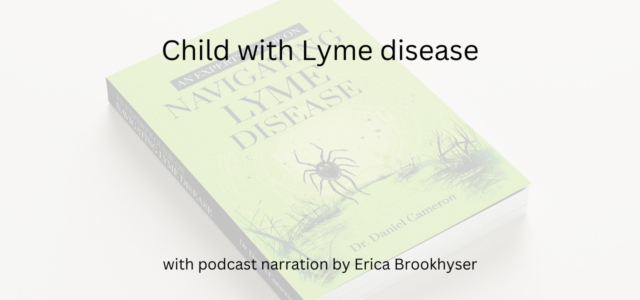Call for your appointment today 914-666-4665 | Mt. Kisco, New York

Welcome to another selection from my book “An Expert’s Guide on Navigating Lyme disease.” The book highlights the findings of my first 600 Lyme disease Science blogs. In this episode, I will discuss children with Lyme disease.
Lyme disease can interfere with learning.
Children with chronic symptoms can suffer both academically and physically. Neurological, psychiatric, and cognitive symptoms can drastically impair an ability to learn and grow in the classroom. In addition, adolescents may struggle socially, unable to connect with their peers or participate, as they once could, in extracurricular activities.
Tager et al. (2001) described 20 children, ages 8 to 16, with “marked fatigue (100%), arthralgias (100%), frequent and severe headaches (100%), irritability/ depression (94%), short-term memory problems (94%), schoolwork deterioration (94%), myalgias (88%), brain fog (88%), neck pain (88%), insomnia (82%), distractibility (82%), word-finding problems (82%), severe flu (80%), sensory hyperacusis to sound (58%) and/or light (74%); insomnia (77%); and radicular pains (56%)” despite antibiotic treatment. Read more.
Children with Lyme may need accommodations in school.
Children with Lyme disease also reported more “learning and attention problems, feelings of ineffectiveness, and mood problems” than controls (Tager et al., 2001). Another study described 25 adolescents with “significant deficits in cognition (short-term visual memory, short-term and delayed verbal memory, all forms of recognition memory), worse attendance, grades, and subjective reports of memory problems” that far exceeded the controls (McAuliffe et al. 2008).
The Individuals with Disabilities Education Act, the Individualized Education Program, and Section 504 of the Rehabilitation Act of 1973 have helped some families via accommodations like shorter school days, untimed tests, alternative testing methods, separate/quieter testing locations, modified home instruction programs, and eliminating unnecessary requirements. Read more.
A teen’s path from martial arts to being in a wheelchair.
A healthy, athletic 18-year-old female was skilled at Taekwondo before suddenly developing a bull’s-eye rash, followed by Bell’s palsy. Over four years, she became increasingly disabled, suffering seizures, and eventually required a wheelchair.
Her symptoms included: cognitive impairments (attention, memory, processing speed, concentration/ executive functioning), tactile hypersensitivity, sun sensitivity, orthostatic hypotension, weight loss, fatigue, non-restorative sleep, pelvic pain, difficulty urinating, headaches, peripheral neuropathy, muscle atrophy, cervical radiculopathy, hair loss, costochondritis, subluxation of multiple joints, and generalized pain.
Clinicians first diagnosed her with fibromyalgia, CFS/ME, hypoglycemia, and “pseudoseizures” rather than psychiatric Lyme disease.
She was eventually diagnosed with “late-stage Lyme borreliosis with multisystem symptoms and porphyria, Ehlers-Danlos/ALPIM syndrome (anxiety-laxity-pain-immune-mood) with seizures caused by increased intracranial pressure from craniocervical instability” (Bransfield and Friedman, 2019).
Upon further evaluation, clinicians diagnosed her with complex partial seizures rather than ‘pseudoseizures’ or psychiatric Lyme disease. “The patient was subsequently treated and is now physically active, married, and leading a productive life” (Bransfield and Friedman, 2019). Read more.
Doctors mistakenly believed Lyme was child abuse.
A 4-year-old boy was evaluated by his pediatrician for an unwitnessed fall while playing in the yard. He presented with “a swollen right knee, a tender left radius without deformity, and what was initially interpreted as a large bruise on the buttock.” The doctor also noted a greenstick forearm fracture and a knee effusion and referred the boy to an orthopedic surgeon. Yet, “Due to the constellation of findings and lack of a witness to the fall, the pediatrician also reported the child to the local County Social Services for Children and Youth due to possible non-accidental trauma” (Pan et al., 2021).
The boy was temporarily placed into foster care. Upon follow-up, the bruising on his buttocks was consistent with a bull’s-eye rash. Lyme disease tests were positive, and he was treated with 30 days of oral amoxicillin.
The authors highlight potential problems with overreporting of child abuse: “Families and individuals under investigation for child abuse often face social isolation which can exacerbate the risk factors for abuse.”
“Families are subjected to investigation, interrogation, separation, and punishment after a report is made.”
“Lastly, the strategy in investigating child abuse arguably deprives accused individuals of their constitutional right to maintain innocence until proven guilty.”
The local County Social Services Children and Youth ended their investigation of the family five days later. They concluded that the child had Lyme disease with an unrelated radius fracture” (Pan et al., 2021). Read more.
[bctt tweet=”Doctors mistakenly believed Lyme was child abuse.” username=”DrDanielCameron”]
A baby girl with Lyme disease.
An otherwise healthy 5-week-old girl was diagnosed with Lyme disease. The baby girl lived in Long Island, New York, an area endemic for Lyme disease. The baby was rarely outdoors, but the family dog may have brought the baby into contact with the tick (Handel et al., 2019).
The doctors were concerned that the baby might suffer from Lyme meningitis. Despite an unsuccessful spinal tap, the doctors treated for Lyme meningitis with intravenous antibiotics. After two weeks of intravenous ceftriaxone, the baby girl was discharged from the hospital (Handel et al., 2019). Read more.
Three premature infants with Babesia from a single donor.
A team of Yale School of Medicine researchers described three premature infants — all in one neonatal intensive care unit — who contracted Babesia from a single 24-year-old blood donor. The report was published in the Pediatric Infectious Diseases Journal (Glanternik et al., 2017).
The 24-year-old donor from Connecticut was not recognized by the blood bank and “was deemed suitable for donation by the American Red Cross, and his serology was negative for all FDA-mandated tests.”
Two of the infants developing high-grade parasitemia (presence of parasites in the blood). Parasitemia rose to 13.4% and 12.5% for Infants A and B, respectively. Parasitemia peaked at 6.8% for Infant C (Glanternik et al., 2017).
All three premature infants were treated with a combination of azithromycin and atovaquone, instead of published recommendations for clindamycin and quinine. “The stability of oral suspension [of quinine] using capsules is undetermined,” explains Glanternik.
“Furthermore, quinine’s narrow therapeutic index and potential adverse effects limit its utility in treating small children.” The infants were treated for 14 days — longer than the 7-10-day recommendation described in the (IDSA) guidelines.
Unfortunately, 48 days after treatment, one of the infants relapsed. The infant was treated with another 23 days of a combination of azithromycin and atovaquone. Read more.
Delayed onset Babesia in two newborns.
A study from the Mayo clinic described two newborn infants diagnosed with Babesia several weeks after the mothers were treated for Lyme disease (Hoversten and Bartlett, 2018).
Infant 1: A baby boy was diagnosed with Babesia at 4 1/2 weeks. His mother had been diagnosed and treated for early Lyme disease at 32 weeks gestation.
Infant 2: A baby girl was diagnosed with Babesia at 18-days old. Her mother had been diagnosed and treated for early Lyme disease at 37 weeks gestation.
The mothers were treated for Babesia during the pregnancy. Read more.
Two mothers transmit Lyme to their babies.
Babesia can be contracted from the bite of a deer tick, a blood transfusion, or during pregnancy. This podcast describes a case in which Babesia was transmitted from the mothers to their babies during pregnancy.
Questions raised in the podcast include: • How often do mothers contract Babesia from a tick bite during pregnancy? • Is there an effective and safe treatment for Babesia in pregnant women? • How does a mother or doctor recognize Babesia in a pregnant mother? • Should doctors follow pregnant mothers with a tick bite or Lyme disease for Babesia and what evidence should be investigated? • Will the mothers develop complications of Babesia in the future if not treated? • Should the two mothers have been treated for Babesia? Read more.
Four children infected with Lyme disease from one camp.
In a ‘Morbidity and Mortality Weekly Report,’ published in January 2020, the Centers for Disease Control and Prevention (CDC) described 4 cases of Lyme disease in children who attended a wilderness day camp in North Carolina (Barbarin et al., 2020).
Out of 35 ticks tested in their camp, 6 were positive for B. burgdorferi sensu stricto (Bbss), the causative agent of Lyme disease. “Results indicated that nymphal ticks collected at the campsite had a B. burgdorferi infection prevalence of 17%” (Barbarin et al., 2020).
Additionally, 1 of the 6 ticks tested positive for Borrelia miyamotoi. Read more.
A child’s Lyme rash was initially dismissed.
A 6-year-old girl presented to her doctor with a circular rash on the left side of her face. The doctor initially assumed the rash was allergic dermatitis. Topical steroids were prescribed, but the rash did not improve (Banadyha et al., 2019).
Over the next 1½ months, the rash spread to the back of the head, and she began exhibiting systemic manifestations, including malaise and a low-grade fever of 37.7 ºC. She lived in an endemic area, but there was no history of a tick bite or a positive test for Lyme disease.
Based on clinical judgment, the 6-year-old was treated with oral cefuroxime. Two weeks after starting antibiotics, Lyme disease was confirmed with a positive IgG Western blot test. “The girl remained asymptomatic at 1.5-year follow-up” (Banadyha et al., 2019). Read more.
Emotional and financial strains on parents and schools.
Many people could be living with Lyme-related chronic illness. “Due to the lack of a single case definition or single shared phenotype for Post Treatment Lyme disease (PTLD), private and public health insurance does not include the costs of caring for these individuals, who must personally pay for these expenses” (Delong et al., 2019).
Children ages 5 to 9, particularly boys, are at a high risk of Lyme disease. A high prevalence of “PTLD” cases would surely be a huge emotional and financial strain on parents, as well as a burden to the school system (Delong et al., 2019). Read more.
Parent’s fears and frustrations for their child.
To better understand the impact of Lyme disease (LD) on families of children with tick-borne illness, correspondence from 23 parents with LD positive children was examined. Parents were recruited from two Canadian Lyme disease support groups (Gaudet et al., 2019).
Lack of knowledge: “My youngest child, who was 10 at the time, had TWO BULLS EYE RASHES on her body … [the doctor said] ‘it can’t be Lyme. There’s no Lyme in [British Columbia].”
Chronic distress: “He continued to get worse… crying all day, sad about being unable to play with his brother, and sad from the pain in his head.”
Missing milestones: “She was not able to undertake the many extracurricular activities that often define the teenage years . . . she has missed out on a lot and will never be able to get those years back . . . she is being left behind.”
Unreliable tests: I think this was one of the worst times for me because I found myself hoping, actually praying that something would show up (on the tests), that they would see something wrong, so they had no choice but to address it. It made me feel like a terrible mother. Who wishes for something to show up on a scan of their child?” “If only doctors were trained to recognize and treat her symptoms instead of relying on a blood test that is known to be inadequate at best, those costs and invasive tests could have been avoided.”
Dismissed by physicians: “She was dismissed from countless medical [appointments] with doctors stating, just ‘take some Tylenol and get on with your life” or ‘lab work is normal, there is nothing else I can do’ . . . she felt put down, demoralized, and abandoned by the mainstream medical community.” Parents often reported that their children faced a broad range of physical, psychological, cognitive, and neurologic symptoms. They also acknowledged how the “diverse and evolving set of symptoms” made it challenging for physicians to diagnose Lyme disease. Read more.
Lingering doubt about doxycycline for children.
Doctors often avoid prescribing doxycycline to young children for fear that it may cause tooth staining, mainly when used in children under 8 years old.
In two studies, which enrolled 89 children, doxycycline did not cause dental staining. Yet, the studies were of short duration and used lower doses of antibiotics than often prescribed for tick-borne illnesses.
“These new studies led to the recommendation in 2018 by the Committee on Infectious Diseases of the American Academy of Pediatrics (AAP) that a course of treatment with doxycycline (for up to 21 days) is safe to prescribe for young children with any infection responsive to this agent, specifically including early Lyme disease” (Wormser 2019). Read more.
Tick bites on children pose a danger.
Children account for 25% of all U.S. Lyme disease cases according to the Centers for Disease Control and Prevention (CDC). Unfortunately, tick bite prevention methods fail our children, as 5-to 9-year-olds are at the highest risk of developing Lyme disease.
The overall infection rate for Borrelia burgdorferi, Anaplasmosis phagocytophilum, and Babesia microti in human-biting ticks were 29.6%, 4.6%, and 1.8%, respectively, writes Xu. Tick bites on a child may cause more than Lyme disease.
- • 1.8% of the ticks were co-infected by B. burgdorferi and A. phagocytophilum. • 1.0% were co-infected by B. burgdorferi and B. microti. • 0.4% were co-infected by A. phagocytophilum and B. microti. • Triple co-infections were found in 0.3% of the ticks
High cost of treating Lyme arthritis with surgery.
Tout et al. (2021) described 149 children admitted to a tertiary care children’s hospital in Pennsylvania diagnosed with Lyme arthritis.
• 1 in 3 children underwent surgery • 2 out of 3 underwent open surgery • The remaining children underwent arthroscopic surgery. One child underwent arthroscopic surgery followed by open surgery. Just over 50% of the children underwent a synovectomy. • Two children were re-admitted for surgical complications — one for wound dehiscence and the other for “persistence of arthritis in the setting of inappropriate initial antibiotic therapy (firstgeneration cephalosporin).” • “One child was admitted due to persistent symptoms despite appropriate antibiotic therapy (doxycycline) for therapeutic arthrocentesis” (Tout et al. 2021). Read more.
Children may be ill for years before diagnosis.
Some children can be ill for months to years before they are diagnosed with Lyme disease. Loved ones should watch for unexplained symptoms, including fatigue and unexplained stomach pain. Are they missing school, sporting events, or other activities?
It was previously believed that seeing a tick bite or a rash on a child was needed to diagnose Lyme disease. This isn’t the case. Less than 1 in 5 children with early Lyme disease described a tick bite (Nigrovic et al., 2019). Awareness is essential, and watching for the symptoms can help prevent a child from living with a chronic illness.
Are they suffering from chronic symptoms for months? If your answer is yes, it is time to schedule a Lyme disease evaluation. Read more.




My 8 year old is suffering from Neuro Lyme, he was top in his class and we had to pull him from school. Please help
How difficult. I hope your doctor’s find an answer soon.